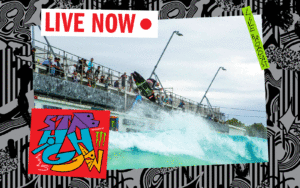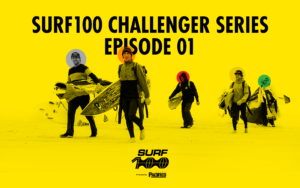Let The Design Revolution Begin…Again
Looking back to fly forward.
Josh Kerr goes finless. Matty Wilkinson, Conner Coffin, Jordy Smith and Seabass hop on swallow-tailed twin fins for a high-line expression session while Shaun Tomson’s on the mic. Besides all the sharks, what the hell was going on in J-Bay?
Experimenting with one’s equipment used to be standard operating procedure amongst the world’s best. Today, open most any tour surfer’s coffin and you’re going to find the exact same 6’0” six times over. That would never have cut it back in the day. In the mid-’70s Terry Fitzgerald earned the monicker “The Sultan of Speed” at J-Bay because he was developing some of the most progressive and innovative single-fin stilettoes at the time, which subsequently flew at J-Bay and pushed the design game forward.
“The public was ready for that,” recalls Hynd, who got his first break from Fitzgerald. “Not everyone was just a drug-crazed moron. There were a lot of artistic people just in love with the spirituality of the sport.”
Fitzgerald’s speed runs soon gave way to the burgeoning pro scene, where shaper/surfers like Mark Richards took things to their logical next step. Looking for a performance edge, he sought to refine the twin-fin design and spent most of his competitive career not only winning on his own boards, but also crafting them himself.
“A well-designed twin fin will work in any conditions from slop to perfection up to 6-foot,” said Richards in an old interview. “A good twin doesn’t solely rely on one element of its design, it is a combination of rockers, outline tail shape, fin positioning, and fin shape. The two most important elements on my twins were the hard resin edge which ran from nose to tail and the concave fluted wing on the bottom. These two elements reduced the slide aspect of the twin fin giving it more drive, direction and holding power.”
Richards won his last world title in ’82, but a couple years prior to that another Aussie surfer/shaper was diligently working on a groundbreaking design of his own. Hunkered down in Narrabeen in 1980, Simon Anderson began experimenting with the three-fin setup. During the next season in ’81, he unveiled his Thruster at Bells, then in Hawaii, where he proved its value by winning the Pipe Masters. Shortly thereafter competitive surfing would never be the same.
“I was looking for something to help give me an advantage. As a bigger guy, I was looking for something that would provide me with more drive and stability. The single-fins and twin-fins weren’t doing that for me unless the waves had enough power, so that was sort of the motivation behind the Thruster,” said Anderson in an interview a couple years ago.
Of course, there were other design contributions over the years. Competitors like Michael Peterson, Reno Abellira and Cheyne Horan all left their fingerprints in the foam dust, but in the ‘80s, when the surfboard evolved to the Thruster and the ASP World Tour blossomed into a legit pro circuit, dramatic experimentation slowed down considerably. Money has a way of stifling creativity. In fact, one could make the argument that until Tom Curren logged his historic Bawa session on the 5’7” Fireball Fish shaped by Tommy Peterson, things had grown downright stagnant.
http://www.youtube.com/watch?v=YolqPak-b54
But here’s where things start to get interesting. On that trip to Bawa, which was organised by Hynd and famously documented by the late Sonny Miller, there were a number of other innovative designs on the boat. At Hynd’s behest, a 7’10” Dave Parmenter Widowmaker and a 6’8″ Channel Islands semi-gun were also onboard. Curren reportedly sampled the 7’10” for about an hour, but came in and grabbed the 5’7″. The public’s love of small, wide boards would catch fire.
Over 20 years down the track and the boards pros ride appear to have once again grown stagnant and boring. This might explain why everyone’s been so eager to dabble in something different at J-Bay this year. Finless surfing, or as Hynd reckons it, free friction surfing, has the potential to be that next vein of innovative surfboard design. Just imagine how far it could go if a talent like Kerr or Coffin were able to free their mind and slide and spin down the line. Hynd likens free friction surfing to jazz—a spontaneous, improvised jam—while conventional thruster surfing is more like straight ahead, three-chord rock n roll. Neither is wrong, neither is bad, but one certainly has the potential to be more interesting and engaging.














Comments
Comments are a Stab Premium feature. Gotta join to talk shop.
Already a member? Sign In
Want to join? Sign Up